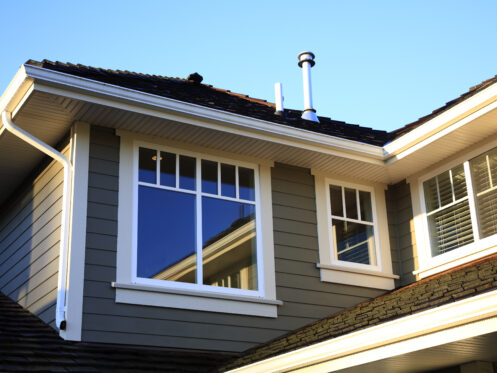New siding should make your home look sharp and perform better against the elements, but only if installed correctly. When it isn’t, small details turn into big problems fast. Even minor installation slip-ups can cost you comfort and money, from warped panels to hidden water damage.
In Carmel, IN, Red Bird Roofing works with homeowners who want their siding done right the first time, with no shortcuts or surprises. If you’re planning a siding project or want to avoid someone else’s mess, here’s what you need to know before the first nail hits the wall.
Nailing the Panels Too Tight
One mistake that catches people off guard is how tightly siding panels get nailed to the wall. It is the right thing to do. Tighter feels more secure. But siding isn’t built to stay fixed in one position. It needs to move slightly as the outside temperature changes. When the panels get nailed down too firmly, they lose that ability. They start to buckle or warp once the heat expands them. You might not see it right away. Then one summer afternoon, your outer wall starts to ripple in the sun.
The panels should hang snug enough to stay in place while sliding side to side with small movements. If you can’t slide the panel with a little pressure after installation, it’s probably too tight. Even one overdriven nail in a long panel can cause uneven pressure along the board; over time, that pressure turns into warping. You don’t want your siding to lock into place. You want it to flex and adjust.
Skipping the Starter Strip or Setting It Too Low
The first piece of siding sets the tone for everything that follows. If that starter strip sits too low or isn’t level, every row that stacks above it drifts in the same direction. You end up with uneven lines across the wall, gaps at the top, or worse, exposed sheathing near the bottom edge that invites water. This isn’t a minor cosmetic issue. Water finds every weak spot it can, and siding that starts off crooked or too close to the ground gives it easy access.
In some cases, the starter strip gets installed below grade, which means it touches soil or mulch. That contact causes moisture problems, invites insects, and speeds up rot behind the panels. Your siding should sit high enough to clear runoff and splash zones but low enough to cover the wall completely. That balance depends on your yard, your foundation, and the siding material itself.
Lack of Proper Flashing Around Openings
Windows and doors interrupt the natural flow of siding, so they need extra attention. Without proper flashing, water sneaks in behind the panels and rests against the frame. Over time, the framing swells, mold grows, and your siding starts to detach. What makes this issue tricky is that the siding can still look perfect from the outside, even while moisture quietly damages the wall beneath.
Every opening needs step flashing or drip caps that guide water away from edges and back onto the face of the siding. Some installers rush through these spots or assume caulk will do the job. Caulk might help seal a seam, but it breaks down with UV exposure and heat. Flashing takes that job off the caulk and gives water a way to exit without doing damage. If your installer skips flashing or cuts corners around trim, it might look fine now, but it won’t hold up when the next big storm hits.
Improper Overlaps or Visible Seams
Where siding panels join together, they should overlap in a way that sheds water away from the wall. If those seams line up vertically or sit too tight without space to breathe, they create visual breaks and functional problems. Water clings to seams, especially when the wind pushes rain against the wall. If the panels don’t overlap far enough, water seeps behind the edge and causes hidden damage.
You might also notice when seams don’t line up with the wall’s layout. They appear too often, land in the middle of windows, or stack on top of each other in odd ways. These layout mistakes don’t always lead to failure, but they break the visual flow and draw attention to poor planning.
Neglecting the Expansion Gap at the Ends
Like the nailing issue, the ends of the siding need space to move. When installers cut panels flush against corners, window trim, or other rigid surfaces, they leave no room for that movement. As the panels expand in the heat, they press against whatever’s in their way. That pressure creates buckling, especially in longer runs of siding.
Instead, installers should leave a small gap between the panel and the edge, then cover it with a J-channel or trim piece. That setup allows the panel to move freely while still looking clean from the outside. If your siding feels tight at the corners or you notice slight bulges near trim edges, you might be looking at a case where that expansion gap didn’t make the cut.
Improper Nail Placement
Not all siding nails go in the same way. Vinyl, fiber cement, and wood each have specific guidelines for how and where to place fasteners. If nails go into the wrong part of the panel, they weaken the board and create pressure points. A nail too high pulls the panel loose, and a nail too low splits it under stress.
Vinyl siding, in particular, has a nail hem designed for movement. The nails should sit in the center of the slot, not at the edges. That middle position lets the panel slide slightly left or right as the weather changes. If all the nails sit on one side of the slot, the panel can’t move properly and will warp.
The same logic applies to spacing. Nails that sit too close together create rigid sections that can’t flex, while nails that are too far apart leave the panel unsupported. The sweet spot depends on the product, but it always comes down to balance.
Ignoring Weather During Installation
Installing siding during extreme weather can lead to long-term problems. In high heat, panels expand while they’re being installed. They shrink in the cold and leave gaps if you nail them in at full length. If you install during cold weather, the panels contract. Nail them tight then, and they’ll buckle when the heat returns. Either way, the wall looks and performs worse than it should.
Installers can work in most weather conditions but must adjust for temperature. That might mean leaving a slightly larger gap in winter or checking expansion clearances more carefully in summer. The material behaves differently depending on the day, and a crew that doesn’t consider that risks building a wall that only looks right during the season it was built.
Humidity matters, too. If you install during wet weather, the wall underneath might trap moisture. Siding needs to breathe. If moisture gets sealed behind the panels, it doesn’t dry out properly, causing rot or mold behind the scenes. That’s why good prep work, dry sheathing, and proper underlayment matter as much as the panels themselves.
Get Your Siding Installed Correctly With Us
Bad siding work doesn’t always show up right away. Sometimes it takes a season or two before the warping, leaking, or energy loss starts to reveal itself. That’s why it pays to slow down, ask questions, and work with people who don’t miss the small stuff. If you’re ready for siding that looks great and lasts, schedule your installation with Red Bird Roofing today.
We also offer gutter installation, attic ventilation upgrades, and window wrapping services to support your home’s exterior alongside professional siding work.






